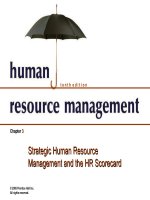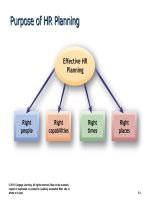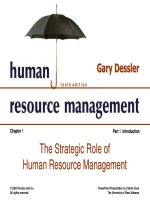Strategic human resource management ch05
Bạn đang xem bản rút gọn của tài liệu. Xem và tải ngay bản đầy đủ của tài liệu tại đây (855.99 KB, 40 trang )
1
Chapter 5
Personnel Planning and Recruiting
FIGURE 5–1
Steps in Recruitment and Selection Process
The recruitment and selection process is a series of hurdles aimed at selecting the best candidate for the job.
5–2
FIGURE 5–2
Linking Employer’s Strategy to Plans
5–3
Planning and Forecasting
• Employment or Personnel Planning
The process of deciding what positions the firm
will have to fill, and how to fill them.
• Succession Planning
The process of deciding how to fill the company’s
most important executive jobs.
• What to Forecast?
Overall personnel needs
The supply of inside candidates
The supply of outside candidates
5–4
Forecasting Personnel Needs
Forecasting
Tools
Trend Analysis
Ratio Analysis
Scatter Plotting
5–5
FIGURE 5–3
Determining the
Relationship
Between Hospital
Size and Number
of Nurses
Note: After fitting the
line, you can project
how many employees
you’ll need, given your
projected volume.
Size of Hospital
(Number
of Beds)
Number of
Registered
Nurses
200
240
300
260
400
470
500
500
600
620
700
660
800
820
900
860
5–6
Drawbacks to Traditional Forecasting
Techniques
• They focus on projections and historical relationships.
• They do not consider the impact of strategic initiatives
on future staffing levels.
• They support compensation plans that reward
managers for managing ever-larger staffs.
• They “bake in” the idea that staff increases are
inevitable.
• They validate and institutionalize present planning
processes and the usual ways of doing things.
5–7
Using Computers to Forecast Personnel
Requirements
• Computerized Forecasts
Software that estimates future staffing needs by:
Projecting
sales, volume of production, and
personnel required to maintain different volumes
of output.
Forecasting
staffing levels for direct labor, indirect
staff, and exempt staff.
Creating
metrics for direct labor hours and three
sales projection scenarios—minimum, maximum,
and probable.
5–8
Forecasting the Supply of
Inside Candidates
Qualification
Inventories
Manual
Systems and
Replacement
Charts
Computerized
Information
Systems
5–9
The Matter of Privacy
• Ensuring the Security of HR Information
Control of HR information through access matrices
Access to records and employee privacy
• Legal Considerations
The Federal Privacy Act of 1974
New York Personal Privacy Act of 1985
HIPAA
Americans with Disabilities Act
5–10
FIGURE 5–5
Keeping Data Safe
Since intruders can strike from outside an organization or from within, HR
departments can help screen out potential identity thieves by following four
basic rules:
1.
Perform background checks on anyone who is going to have access
to personal information.
2.
If someone with access to personal information is out sick or on leave,
don’t hire a temporary employee to replace him or her. Instead,
bring in a trusted worker from another department.
3.
Perform random background checks such as random drug tests.
Just because someone passed five years ago doesn’t mean their
current situation is the same.
4.
Limit access to information such as SSNs, health information, and
other sensitive data to HR managers who require it to do their jobs.
5–11
Forecasting Outside Candidate Supply
• Factors In Supply of Outside Candidates
General economic conditions
Expected unemployment rate
• Sources of Information
Periodic forecasts in business publications
Online economic projections
U.S.
Department of Labor’s O*NET™
Bureau
Other
of Labor Statistics (BLS)
federal agencies and private sources
5–12
Effective Recruiting
• What Makes Recruiting a challenge
Consistency of recruitment with strategic goals
Types of jobs recruited and recruiting methods
Nonrecruitment HR issues and policies
Public image of the firm
Employment laws
5–13
Effective Recruiting (cont’d)
• Advantages of Centralizing Recruitment
Facilitates applying strategic priorities
Reduces duplication of HR activities
Reduces cost of new HR technologies
Builds teams of HR experts
Provides better measurement of HR performance
Allows for sharing of applicant pools
5–14
TABLE 5–1
Selection Devices that Could be Used to Initially Screen Applicants
Selection Device
Validity for Predicting Job
Performance*
Construct
General mental ability tests
0.51
Conscientiousness tests
0.31
Integrity tests
0.41
Method
Work sample tests
0.54
Job knowledge tests
0.48
Structured interviews
0.51
Biographical data
0.35
Grade point average
0.23
Ratings of training and experience
0.11
Note: *Higher is better.
Source: Kevin Carlson et al., “Recruitment Evaluation: The Case for Assessing
the Quality of Applicants Attracted,” Personnel Psychology 55 (2002), p. 470.
5–15
FIGURE 5–7
Recruiting Yield Pyramid
5–16
Internal Candidates: Hiring from Within
Advantages
• Foreknowledge of
candidates’ strengths and
weaknesses
• More accurate view of
candidate’s skills
• Candidates have a
stronger commitment to
the company
• Increases employee
morale
• Less training and
orientation required
Disadvantages
• Failed applicants become
discontented
• Time wasted interviewing
inside candidates who will
not be considered
• Inbreeding strengthens
tendency to maintain the
status quo
5–17
Finding Internal Candidates
Rehiring Former
Employees
Job Posting
Hiring from
Within
Succession
Planning (HRIS)
5–18
Succession Planning
•
•
•
Identify key needs
Develop inside candidates
Assess and choose
5–19
Outside Sources of Candidates
Locating Outside Candidates
1
Recruiting via the Internet
6
Executive Recruiters
2
Advertising
7
On Demand Recruiting
Services (ODRS)
3
Employment Agencies
8
College Recruiting
4
Temp Agencies and Alternative
Staffing
9
Referrals and Walk-ins
5
Offshoring/Outsourcing
5–20
Outside Sources of Candidates (cont’d)
• Recruiting via the Internet
Advantages
Cost-effective way to publicize job openings
More applicants attracted over a longer period
Immediate applicant responses
Online prescreening of applicants
Links to other job search sites
Automation of applicant tracking and evaluation
Disadvantages
Exclusion of older and minority workers
Excessive number of unqualified applicants
Personal information privacy concerns of applicants
5–21
FIGURE 5–9
Ineffective and Effective Web Ads
Source: Workforce, December 2001, © Crain Communication, Inc. Reprinted with permission.
5–22
Advertising for Outside Candidates
• 1.The Media Choice
Selection of the best medium depends on the
positions for which the firm is recruiting.
Newspapers:
local and specific labor markets
Trade
and professional journals: specialized
employees
Internet
job sites: global labor markets
• 2.Constructing the Ad
Create attention, interest, desire, and action (AIDA).
Create a positive impression of the firm.
5–23
FIGURE 5–10
Help Wanted Ad That Draws Attention
Source: The New York Times, May 13, 2007, Business p. 18.
5–24
Employment Agencies
Types of
Employment
Agencies
Public
Agencies
Nonprofit
Agencies
Private
Agencies
5–25









